COVID-19: TCTMD’s Daily Dispatch for March Week 2
We’re curating a list of COVID-19 research and other useful content, and updating it daily.

TCTMD reporter Todd Neale is keeping up on breaking news and peer-reviewed research related to COVID-19 and will update daily. If you have something to share, tell us. All of our COVID-19 coverage can be found on our COVID-19 Hub.
March 12, 2021
 Concerning news continues to come out of Brazil, where hospitals in its major cities are reaching capacity and the world’s highest COVID-19 death toll over the past week was recorded, Reuters reports. “Intensive care wards for treating COVID-19 patients have reached critical occupancy levels over 90% in 15 of 27 state capitals, according to biomedical center Fiocruz. In Porto Alegre in southern Brazil, the main reference hospital for COVID-19 stopped admitting new cases because all its ICU beds were taken. A Reuters photographer saw patients on respirators crowding emergency rooms.”
Concerning news continues to come out of Brazil, where hospitals in its major cities are reaching capacity and the world’s highest COVID-19 death toll over the past week was recorded, Reuters reports. “Intensive care wards for treating COVID-19 patients have reached critical occupancy levels over 90% in 15 of 27 state capitals, according to biomedical center Fiocruz. In Porto Alegre in southern Brazil, the main reference hospital for COVID-19 stopped admitting new cases because all its ICU beds were taken. A Reuters photographer saw patients on respirators crowding emergency rooms.”
In response to reports of blood clots that have developed in people who have received the COVID-19 vaccine from the University of Oxford and AstraZeneca, prompting several countries to suspend its use, regulators around the world are supporting the vaccine’s safety, saying that the benefits continue to outweigh the risks. That now includes Health Canada, echoing the assessment of the European Medicines Agency (EMA). The World Health Organization (WHO) also has said there’s no reason to stop using the vaccine, BBC News reports.
The EMA’s safety committee did conclude, however, that anaphylaxis and hypersensitivity should be listed as side effects on the Oxford/AstraZeneca vaccine’s label. “The update is based on a review of 41 reports of possible anaphylaxis seen among around 5 million vaccinations in the United Kingdom,” the agency said. “After careful review of the data, [the safety committee] considered that a link to the vaccine was likely in at least some of these cases.”
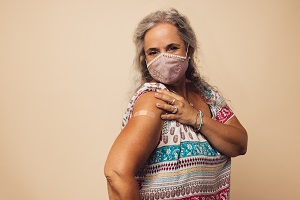 The United States is holding a stockpile of tens of millions of doses of the Oxford/AstraZeneca vaccine, which has not yet received an emergency use authorization from the US Food and Drug Administration (FDA). And, the New York Times reports, countries that have authorized its use are pleading for the doses, with the support of AstraZeneca. “We understand other governments may have reached out to the US government about donation of AstraZeneca doses, and we’ve asked the US government to give thoughtful consideration to these requests,” a company spokesperson said.
The United States is holding a stockpile of tens of millions of doses of the Oxford/AstraZeneca vaccine, which has not yet received an emergency use authorization from the US Food and Drug Administration (FDA). And, the New York Times reports, countries that have authorized its use are pleading for the doses, with the support of AstraZeneca. “We understand other governments may have reached out to the US government about donation of AstraZeneca doses, and we’ve asked the US government to give thoughtful consideration to these requests,” a company spokesperson said.
Community exposures appear to be more important than workplace exposures when it comes to risk of contracting SARS-CoV-2 among healthcare workers, a study in JAMA Network Open suggests. The strongest risk factor for SARS-CoV-2 seropositivity was contact with an individual known to have COVID-19 outside the workplace; living in a zip code with higher COVID-19 incidence was another risk factor. None of the studied workplace factors, however, were associated with seropositivity. The findings indicate that “that current infection prevention strategies in healthcare are effective in preventing patient-to-HCP transmission in the workplace,” the authors say.
Russia and China are looking to secure their places when it comes to providing COVID-19 vaccines for Africa, where many countries have not yet started administering shots, Reuters reports. “But, so far, vaccine donations from Beijing and Moscow have been small, the commercial deals they offer are costly, and some African governments are wary about a lack of data.” John Nkengasong, MSc, PhD, director of the Africa Centers for Disease Control and Prevention said Thursday that the continent, which trails other parts of the world when it comes to vaccination, must develop the capability to produce its own vaccines, according to the Associated Press.
US President Joe Biden said in a national address on Thursday that he will compel state, local, and tribal governments—using the authority of the Department of Health and Human Services (HHS)—to make all Americans eligible to sign up to receive a COVID-19 vaccine by May 1. “The goal, Biden aides told reporters on a conference call, is to allow Americans to gather in relative normalcy by July 4,” STAT reports.
Additional US states are looking to lift their COVID-19 restrictions. Oklahoma Governor Kevin Stitt said statewide restrictions will be removed in response to increasing numbers of vaccinations and decreasing numbers of infections and hospitalizations, the Associated Press reports. And Minnesota Governor Tim Walz said he’s planning significant rollbacks of limitations on the sizes of gatherings.
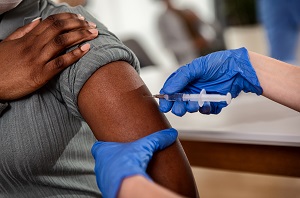 Most of the world’s poorest countries—at least 47 of 79 low- or lower-middle-income countries (59%)—have not administered any COVID-19 vaccine shots, according to a Yahoo Life story. “Doses from COVAX are due in the coming days; however, the People's Vaccine Alliance warns the amount available means only 3% of people living in less-developed countries will be vaccinated by mid-2021 and at best just one-fifth by the end of the year.”
Most of the world’s poorest countries—at least 47 of 79 low- or lower-middle-income countries (59%)—have not administered any COVID-19 vaccine shots, according to a Yahoo Life story. “Doses from COVAX are due in the coming days; however, the People's Vaccine Alliance warns the amount available means only 3% of people living in less-developed countries will be vaccinated by mid-2021 and at best just one-fifth by the end of the year.”
Unpublished data gathered by the Israel Ministry of Health shows that the Pfizer/BioNTech vaccine is at least 97% effective at preventing symptomatic disease, severe/critical disease, and death 2 weeks after the second dose, Pfizer announced Thursday. The analysis also demonstrated 94% effectiveness against asymptomatic SARS-CoV-2 infections. Detailed findings will be submitted to a peer-reviewed journal.
Novavax said Thursday that its COVID-19 vaccine was 96% effective against the original strain of SARS-CoV-2 in a trial conducted in the United Kingdom, and 86% effective against the more-infectious B.1.1.7 variant, Reuters reports. The works out to a combined effectiveness rate of 90%. In a smaller trial conducted in South Africa, where participants were exposed to another more-infectious variant, effectiveness was lower (55%).
March 11, 2021
 The world reached an unwelcome milestone today, which marks 1 year since the World Health Organization (WHO) officially declared the COVID-19 crisis a pandemic. As NPR notes, on March 11, 2020—ie, “The Day Everything Changed”—Anthony Fauci, MD, director of the US National Institute of Allergy and Infectious Diseases (NIAID), testified before a US House of Representatives committee. He was asked if the worst was yet to come. “Yes, it is,” replied Fauci, who would soon become a household name.
The world reached an unwelcome milestone today, which marks 1 year since the World Health Organization (WHO) officially declared the COVID-19 crisis a pandemic. As NPR notes, on March 11, 2020—ie, “The Day Everything Changed”—Anthony Fauci, MD, director of the US National Institute of Allergy and Infectious Diseases (NIAID), testified before a US House of Representatives committee. He was asked if the worst was yet to come. “Yes, it is,” replied Fauci, who would soon become a household name.
The Associated Press describes how the WHO is still struggling with the pandemic response a full year later, Roll Coll delves into how healthcare has changed, and NBC News provides “an oral history of the day that changed America.”
Though the picture is mixed depending on where you look, there are signs that the world is turning a corner as vaccinations continue to roll out. Forbes reports that the United States is averaging fewer than 50,000 new COVID-19 cases a day for the first time in more than 5 months. Centers for Disease Control and Prevention (CDC) Director Rochelle Walensky, MD, said Wednesday that “all this is good news,” noting that after a recent plateau, cases seem to be trending down again.
As CIDRAP News points out, however, COVID-19 activity continues to vary across the globe. The Pan American Health Organization (PAHO) warned Wednesday, for instance, that even though new cases are falling in North America, infections are still rising in Latin America, particularly in Brazil, Reuters reports.
According to the Johns Hopkins COVID-19 Dashboard, there are now more than 118 million confirmed COVID-19 cases and 2.6 million deaths worldwide, with the United States leading in both categories (29 million and 529,000).
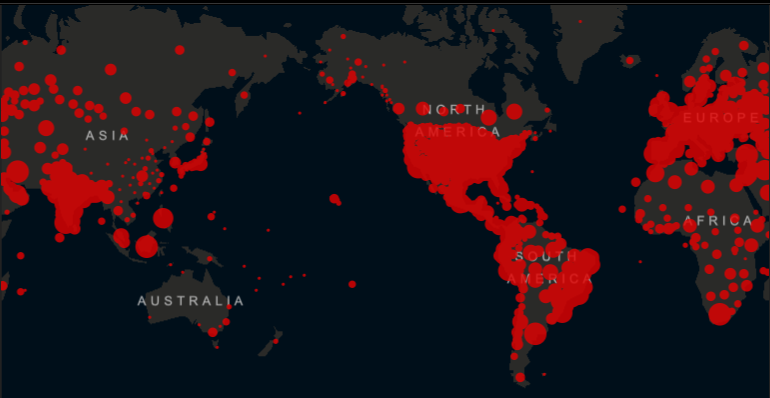
Following a similar move by Austria earlier this week, Denmark has suspended use of the COVID-19 vaccine from the University of Oxford and AstraZeneca following reports of severe blood clots in people who have received the shot, CNBC reports. The Danish Health Authority says in a press release “it is too early to conclude whether there is a link between the vaccine and the blood clots.” The European Medicines Agency (EMA) says it’s investigating the issue, adding that the view of its safety committee “is that the vaccine’s benefits continue to outweigh its risks and the vaccine can continue to be administered while investigation of cases of thromboembolic events is ongoing.” There is no indication the vaccine was responsible for the cases seen in Austria, it said yesterday.
The EMA also announced Wednesday that it has recommended granting a conditional marketing authorization for the Janssen COVID-19 vaccine from Johnson & Johnson, to be used in people 18 and older. It is the fourth COVID-19 vaccine recommended for use in Europe. The agency has also initiated a rolling review of Eli Lilly’s combination antibody treatment (bamlanivimab and etesemivab). The review will also consider bamlanivimab alone.
Compared with remdesivir alone, a combination of the monoclonal antibody tocilizumab and the antiviral remdesivir did not improve time to hospital discharge up to day 28 in patients with severe COVID-19 pneumonia in the phase III REMDACTA trial conducted in collaboration with Gilead Sciences, Roche announced Wednesday. The company notes that one prior trial of tocilizumab (EMPACTA) met its primary endpoint, whereas another (COVACTA) did not. “We continue to believe that the totality of data suggests a potential role for [tocilizumab] in treating certain patients with COVID-19, and will discuss the results with health authorities,” a Roche official said in a press release.
Another monoclonal antibody—VIR-7831—provided positive results in the phase III COMET-ICE trial, drugmakers Vir Biotechnology and GlaxoSmithKline announced Wednesday. An interim analysis showed that VIR-7831 monotherapy reduced hospitalization or death by 85% in adults with COVID-19 who were at high risk for hospitalization. The companies plan on applying for an emergency use authorization from the US Food and Drug Administration (FDA).
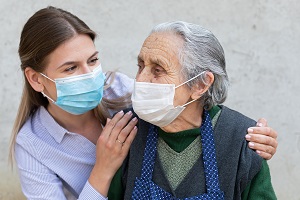 US nursing home residents who have been vaccinated against COVID-19 can get hugs from their friends and family members again, the Associated Press reports, after the Centers for Medicare & Medicaid Services (CMS) updated its visitation recommendations. “There is no substitute for physical contact, such as the warm embrace between a resident and their loved one,” CMS said in its new guidance. “Therefore, if the resident is fully vaccinated, they can choose to have close contact (including touch) with their visitor while wearing a well-fitting face mask and performing hand hygiene before and after.”
US nursing home residents who have been vaccinated against COVID-19 can get hugs from their friends and family members again, the Associated Press reports, after the Centers for Medicare & Medicaid Services (CMS) updated its visitation recommendations. “There is no substitute for physical contact, such as the warm embrace between a resident and their loved one,” CMS said in its new guidance. “Therefore, if the resident is fully vaccinated, they can choose to have close contact (including touch) with their visitor while wearing a well-fitting face mask and performing hand hygiene before and after.”
A study by Pew Charitable Trusts researchers highlights the overuse of antibiotics during the first 6 months of the COVID-19 pandemic in the United States. Patients received an antibiotic in more than half of COVID-19 hospitalizations, with about one-third of admissions involving prescription of more than one antibiotic. Only 29% of patients admitted for COVID-19 had a diagnosed bacterial infection, however. “What our study really highlights is the important need to focus on antibiotic prescribing in this population, and to ensure that antibiotic stewardship programs are well positioned to improve prescribing a year into the pandemic,” a study co-author told CIDRAP News.
In JACC: Case Reports, Swedish researchers detail the occurrence of postural orthostatic tachycardia syndrome (POTS) in three patients presenting more than 3 months after recovering from COVID-19, highlighting the issue as something to watch out for in long-haulers. “Much remains unknown about the specific mechanisms responsible for the POTS-like symptoms in post-COVID-19 patients or how long these symptoms will last but chronic symptoms are expected in a subset of patients based on this initial clinical experience,” they say.
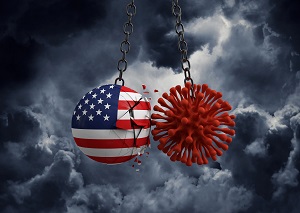 The spread of SARS-CoV-2 increased the US death rate by 15% in 2020, “making it the deadliest year in recorded US history, the [CDC] will announce, according to two senior administration officials with direct knowledge of the matter,” Politico reports. The analysis, expected to be published in Morbidity and Mortality Weekly Report, shows COVID-19 was the third leading cause of death among Americans, behind heart disease and cancer. It bumped “unintentional injuries” down a spot. “The upcoming report will mark the first time the agency has publicly acknowledged that the national death rate spiked last year and that COVID-19 played a role in the increase,” according to the story. KHN digs into how COVID-19 compares with other causes of death.
The spread of SARS-CoV-2 increased the US death rate by 15% in 2020, “making it the deadliest year in recorded US history, the [CDC] will announce, according to two senior administration officials with direct knowledge of the matter,” Politico reports. The analysis, expected to be published in Morbidity and Mortality Weekly Report, shows COVID-19 was the third leading cause of death among Americans, behind heart disease and cancer. It bumped “unintentional injuries” down a spot. “The upcoming report will mark the first time the agency has publicly acknowledged that the national death rate spiked last year and that COVID-19 played a role in the increase,” according to the story. KHN digs into how COVID-19 compares with other causes of death.
March 10, 2021
The SARS-CoV-2 variant that was first detected in the United Kingdom and has since started spreading around the world—called B.1.1.7—is not only more transmissible, but it also carries a higher mortality risk (HR 1.64), a cohort study in the BMJ indicates. The researchers estimated an increase from 2.5 to 4.1 deaths per 1,000 detected cases with this new variant, and the higher mortality risk is consistent with preliminary evidence from other sources. “Coupled with its ability to spread rapidly, this makes B.1.1.7 a threat that should be taken seriously,” one of the researchers said in a Reuters story.
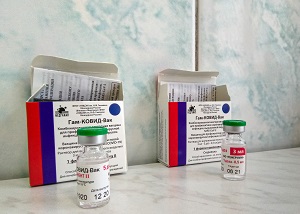 Russia will make its Sputnik V COVID-19 vaccine in Italy, the first such contract in the European Union, the Associated Press reports. The plan is to produce 10 million doses this year, starting in July. “The innovative production process will help create new jobs and allow Italy to control the entire production of the compound,” the Italian Russian Chamber of Commerce announced Tuesday. Sputnik V has not yet been authorized for use in Europe, although the European Medicines Agency (EMA) initiated a rolling review of the vaccine last week.
Russia will make its Sputnik V COVID-19 vaccine in Italy, the first such contract in the European Union, the Associated Press reports. The plan is to produce 10 million doses this year, starting in July. “The innovative production process will help create new jobs and allow Italy to control the entire production of the compound,” the Italian Russian Chamber of Commerce announced Tuesday. Sputnik V has not yet been authorized for use in Europe, although the European Medicines Agency (EMA) initiated a rolling review of the vaccine last week.
Alaska became the first US state to make COVID-19 vaccines available to anyone 16 or older who lives or works there, effective immediately, CNBC reports. That move comes as other states continue to prioritize vaccination for higher-risk populations, like the elderly, healthcare workers, and those with underlying conditions.
Racial/ethnic disparities in the incidence of COVID-19 among Americans younger than 25—with minority groups disproportionately affected—were greater early in the pandemic, according to a study in Morbidity and Mortality Weekly Report. The differences became smaller after May 2020, although that was explained by a larger increase in incidence among white individuals rather than a decline in minority populations. “Ensuring equitable and timely access to preventive measures, including testing, safe work and education settings, and vaccination when eligible, is important to address racial/ethnic disparities,” the authors write.
 The American College of Cardiology’s Competency Management Committee released a statement discussing competency-based medical education (CBME) for fellowship training during the pandemic. “In brief, we urge both board certification bodies and credentialing authorities to consider adopting strategies that permit some flexibility while still maintaining the protection of the public interest,” the authors write.
The American College of Cardiology’s Competency Management Committee released a statement discussing competency-based medical education (CBME) for fellowship training during the pandemic. “In brief, we urge both board certification bodies and credentialing authorities to consider adopting strategies that permit some flexibility while still maintaining the protection of the public interest,” the authors write.
New phase III data from the BLAZE-1 trial show that an antibody therapy from Eli Lilly—combining bamlanivimab and etesevimab—reduces COVID-19-related hospitalizations and deaths in newly diagnosed high-risk patients, the company announced in a press release Wednesday. There were four deaths in this cohort, all in the placebo arm. “The consistent results observed in multiple cohorts of this trial over several months, even as new strains of COVID-19 have emerged, indicate bamlanivimab with etesevimab maintains its effects against a range of variants, particularly those circulating in the US,” the company’s chief scientific officer said. The combination received an emergency use authorization from the US Food and Drug Administration (FDA) last month.
The empty vial from the first COVID-19 vaccination administered in the United States will be put on display at the Smithsonian’s National Museum of American History as part of a new exhibition next year, along with a vaccination card, hospital ID, and scrubs from the recipient of that shot, ICU nurse Sandra Lindsay. “These now historic artifacts document not only this remarkable scientific progress, but represent the hope offered to millions living through the cascading crises brought on by COVID-19,” the museum’s director said a story in Smithsonian Magazine.
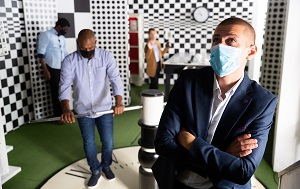 A Monmouth University Poll shows that about one-quarter of Americans are still unwilling to get a COVID-19 vaccine. It also indicates that people are increasingly negative when it comes to predicting when the pandemic will be brought under control: 21% of Americans now think things will return to normal by summer, down from 29% in January. Another 40% predict normalcy by the end of the year, 27% think it’ll take longer, and 9% say a return to normal will never happen.
A Monmouth University Poll shows that about one-quarter of Americans are still unwilling to get a COVID-19 vaccine. It also indicates that people are increasingly negative when it comes to predicting when the pandemic will be brought under control: 21% of Americans now think things will return to normal by summer, down from 29% in January. Another 40% predict normalcy by the end of the year, 27% think it’ll take longer, and 9% say a return to normal will never happen.
As we approach the 1-year anniversary of the World Health Organization’s official declaration of the COVID-19 pandemic, STAT’s Patrick Skerrett spoke with eight experts about when they realized COVID-19 would be a major problem. Writer David Quammen said, “The moment last year when I realized, more immediately, that the world could be in real trouble was on Jan. 13, 2020, when I was reading an email from the disease reporting service ProMED, about the cluster of atypical pneumonias in the city of Wuhan, and I saw for the first time, on the subject line and in the text, the words ‘novel coronavirus.’”
 The pandemic has affected women and men differently, a pair of new studies suggest. In PNAS, researchers report that across five countries, women—particularly mothers—spent more time caring for children and doing chores compared with men; more time spent on chores was associated with lower well-being. Similarly, a UK study in PLOS ONE showed that women bore the brunt of childcare and housework during lockdown and were more likely than men to make changes to their employment schedules. Psychological distress levels increased along with hours of unpaid care work.
The pandemic has affected women and men differently, a pair of new studies suggest. In PNAS, researchers report that across five countries, women—particularly mothers—spent more time caring for children and doing chores compared with men; more time spent on chores was associated with lower well-being. Similarly, a UK study in PLOS ONE showed that women bore the brunt of childcare and housework during lockdown and were more likely than men to make changes to their employment schedules. Psychological distress levels increased along with hours of unpaid care work.
March 9, 2021
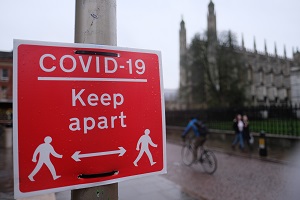 On Tuesday, top UK medical and scientific advisors urged caution on lifting COVID-19-related restrictions, stressing the need for a gradual reopening, Reuters reports. Deaths are on the decline and the vaccine rollout is going well, the prime minister’s chief scientific advisor said, but the situation could still take a turn for the worse. “It’s all pointing in the right direction, but I think nobody can say with certainty that this is . . . finished,” he told lawmakers. “We’re certainly not out of the woods yet, even on this wave.”
On Tuesday, top UK medical and scientific advisors urged caution on lifting COVID-19-related restrictions, stressing the need for a gradual reopening, Reuters reports. Deaths are on the decline and the vaccine rollout is going well, the prime minister’s chief scientific advisor said, but the situation could still take a turn for the worse. “It’s all pointing in the right direction, but I think nobody can say with certainty that this is . . . finished,” he told lawmakers. “We’re certainly not out of the woods yet, even on this wave.”
The RECOVERY trial recently closed recruitment to the colchicine arm after the data monitoring committee “saw no convincing evidence that further recruitment would provide conclusive proof of worthwhile mortality benefit either overall or in any prespecified subgroup” compared with usual care in hospitalized COVID-19 patients, according to a press release. Earlier, treatment with colchicine yielded positive results in nonhospitalized patients in the COLCORONA trial and in patients hospitalized with moderate-to-severe disease in a small trial.
Medicare spending on physician services fell by as much as 57% below expected levels in April 2020, the early phase of the COVID-19 pandemic in the United States, according to a new report from the American Medical Association (AMA). Though that initial drop was followed by a recovery, spending was still 12% below normal by the end of June 2020. Cardiovascular Business delves into the impact on providers of cardiology services, who lost an estimated $506 million in the early stages of the pandemic.
A study of Mass General Brigham employees, published in JAMA, shows that 2.1% had an acute allergic reaction to their first dose mRNA COVID-19 vaccine, with a slightly higher rate seen with the Pfizer/BioNTech shot than with the Moderna vaccine (2.20% vs 1.95%). Anaphylaxis occurred in 16 people (0.025%), with no difference between vaccines; all recovered. The rate of anaphylaxis is higher than previously reported by the US Centers for Disease Control and Prevention (CDC), but risk “remains extremely low and largely comparable to other common healthcare exposures,” the researchers say.
Researchers have uncovered racial differences in the management and outcomes of acute MI during the COVID-19 pandemic. In Heart, they report that black, Asian, and minority ethnic (BAME) individuals were more likely to be hospitalized with acute MI and had higher in-hospital mortality during versus before the pandemic. They were also less likely than their white counterparts to receive guideline-recommended care. “There is a need to develop clinical pathways to achieve equity in the management of these vulnerable populations,” the authors conclude.
 Universities across the United States are shortening spring break or canceling it outright in an attempt to discourage large parties that could lead to another surge in SARS-CoV-2 cases, the Associated Press reports. Texas A&M University, for example, is going with a 3-day weekend instead of a whole week, whereas the University of Alabama and the University of Wisconsin-Madison eliminated the break altogether and will give students a day off later in the semester. At the top of its spring break travel guidance, the CDC recommends staying home.
Universities across the United States are shortening spring break or canceling it outright in an attempt to discourage large parties that could lead to another surge in SARS-CoV-2 cases, the Associated Press reports. Texas A&M University, for example, is going with a 3-day weekend instead of a whole week, whereas the University of Alabama and the University of Wisconsin-Madison eliminated the break altogether and will give students a day off later in the semester. At the top of its spring break travel guidance, the CDC recommends staying home.
A lab study indicates that the Pfizer/BioNTech COVID-19 vaccine neutralizes the SARS-CoV-2 variant first detected and rapidly spreading in Brazil, Reuters reports. The study, published as a research letter in the New England Journal of Medicine, also suggests the vaccine may be less effective against the variant that first arose in South Africa, consistent with other analyses, including a new one in Nature. “Ultimately, conclusions about vaccine-mediated protection that are extrapolated from neutralization or T-cell data must be validated by real-world evidence collected in regions where the SARS-CoV-2 variants are circulating,” the NEJM researchers say.
The more-transmissible SARS-CoV-2 variant that first emerged in the UK—called B.1.1.7—is now widespread in Houston, TX, with the city’s health department reporting Monday that it has been found in most of its wastewater treatment plants, “suggesting ongoing and uncontrolled community spread.” Houston’s mayor said in a statement that he is concerned, “especially at a time when the State of Texas is easing mandates on measures proven to reduce transmission and ultimately save lives. Despite the mixed messaging, this is a clear indication that it is too soon to stop requiring masks in public places. I urge all Houstonians to continue masking up to protect their families and community.”
The B.1.1.7 variant is also spreading widely in Florida, sparking worries of a potential surge in COVID-19 cases to come, Bloomberg reports. Though hospitalizations and deaths have fallen from recent highs, there are some indicators of concern: “The per-capita rate of COVID-19 patients currently in Florida hospitals is now about 25% above the national average. And new patients are arriving at its hospital emergency departments at slightly higher rates than the rest of the country.”
Japan reportedly has decided to hold this summer’s Tokyo Olympic and Paralympic Games, already delayed a year, without allowing overseas spectators. The Kyoto news agency reported the decision, citing unnamed officials, although the committee organizing the games said a decision would be made by the end of the month. The Olympics are scheduled for July 23 to August 8, and the Paralympics are scheduled for August 24 to September 5.
It looks like Mexico will rely on vaccines made in China to deal with the pandemic. A Mexican official said the government has signed deals for 12 million doses of the Sinopharm vaccine, which has not yet been approved, and increased its order of the CoronaVac vaccine made by Sinovac to a total of 20 million doses, the Associated Press reports. Mexico will also have at least 4 million doses of the Chinese-made CanSino vaccine. Only about 5 million doses have been acquired from other sources.
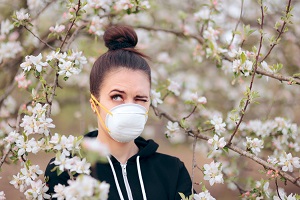 Exposure to airborne pollen may enhance susceptibility to SARS-CoV-2 infection, a PNAS study based on data from 31 countries suggests. “We found that pollen, sometimes in synergy with humidity and temperature, explained, on average, 44% of the infection rate variability. Lockdown halved infection rates under similar pollen concentrations,” the researchers report. “As we cannot completely avoid pollen exposure, we suggest wide dissemination of pollen-virus co-exposure information to encourage high-risk individuals to wear particle filter masks during high springtime pollen concentrations.”
Exposure to airborne pollen may enhance susceptibility to SARS-CoV-2 infection, a PNAS study based on data from 31 countries suggests. “We found that pollen, sometimes in synergy with humidity and temperature, explained, on average, 44% of the infection rate variability. Lockdown halved infection rates under similar pollen concentrations,” the researchers report. “As we cannot completely avoid pollen exposure, we suggest wide dissemination of pollen-virus co-exposure information to encourage high-risk individuals to wear particle filter masks during high springtime pollen concentrations.”
March 8, 2021
On Monday, the US Centers for Disease Control and Prevention (CDC) released guidance about what people can do once they’ve been vaccinated. As the Washington Post reports, the CDC “said people who are 2 weeks past their final shot face little risk if they visit indoors with unvaccinated members of a single household at low risk of severe disease, without wearing masks or distancing. That would free many vaccinated grandparents who live near their unvaccinated children and grandchildren to gather for the first time in a year.” The agency also said fully vaccinated people can meet indoors with other fully vaccinated people. A story from STAT has more.
Canada will be the first country to have access to four COVID-19 vaccines after Health Canada cleared the Janssen COVID-19 vaccine from Johnson & Johnson late last week, the Associated Press reports. “Like many countries, Canada does not have domestic production and has struggled with an immediate shortage of vaccines. The US so far isn’t allowing locally made vaccines to be exported, so Canada—like the other US neighbor, Mexico—has been forced to get vaccines from Europe and Asia.”
 Reassuring data published in JAMA Cardiology show a low incidence of myocarditis—just 0.6%—among professional athletes diagnosed with COVID-19. The new findings should provide reassurances after a number of recent cardiac magnetic resonance (CMR) studies, including some in athletes, suggested that even asymptomatic or mildly symptomatic COVID-19 could result in cardiac injury, TCTMD’s Michael O’Riordan reports.
Reassuring data published in JAMA Cardiology show a low incidence of myocarditis—just 0.6%—among professional athletes diagnosed with COVID-19. The new findings should provide reassurances after a number of recent cardiac magnetic resonance (CMR) studies, including some in athletes, suggested that even asymptomatic or mildly symptomatic COVID-19 could result in cardiac injury, TCTMD’s Michael O’Riordan reports.
Syrian President Bashar Al-Assad and his wife Asma have both tested positive for COVID-19, CNN reports. According to a statement, both are in stable condition and plan to self-isolate for 2 or 3 weeks. “Syria has recorded at least 45,879 positive COVID-19 cases and 2,023 total deaths based on cumulative numbers of multiple local medical authorities, but a full picture of the outbreak in the country has been difficult to get,” the story notes.
Scientists have found a SARS-CoV-2 variant in Oregon that carries a concerning mutation, the New York Times reports. The strain consists of a more-transmissible variant first identified in the United Kingdom combined with a mutation that might weaken the efficacy of vaccines. “The researchers have so far found just a single case of this formidable combination, but genetic analysis suggested that the variant had been acquired in the community and did not arise in the patient.” The finding was reported in a database shared by scientists.
 In Japan, vending machines have been set up in the greater Tokyo area to ease access to COVID-19 testing, Reuters reports. The government restricts its own testing to people who have a lot of symptoms or who are likely to have been infected, and “that’s led to the public to rely heavily on private clinics or buying PCR tests by other means.”
In Japan, vending machines have been set up in the greater Tokyo area to ease access to COVID-19 testing, Reuters reports. The government restricts its own testing to people who have a lot of symptoms or who are likely to have been infected, and “that’s led to the public to rely heavily on private clinics or buying PCR tests by other means.”
Reaffirming the link between obesity and poorer COVID-19 outcomes, a study in Morbidity and Mortality Weekly Report (MMWR) shows that overweight and obesity are risk factors for invasive mechanical ventilation and that obesity is a risk factor for hospitalization and death, especially in those younger than 65.
Austria has suspended use of a batch of the COVID-19 vaccine from the University of Oxford and AstraZeneca after one person died and another fell ill after receiving the shot, Reuters reports. A 49-year-old women died of severe coagulation disorders and a 35-year-old woman is recovering after developing a pulmonary embolism. A federal health agency said there is no evidence of a causal link to vaccination, but the cases are being investigated.
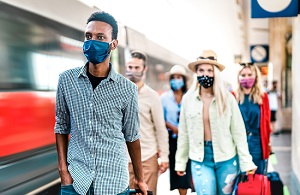 Another study in MMWR shows that mask mandates in the United States were associated with declines in daily COVID-19 case and death growth rates within 20 days of implementation. On the flip side, allowing restaurant dining was associated with increases in both figures. “Policies that require universal mask use and restrict any on-premises restaurant dining are important components of a comprehensive strategy to reduce exposure to and transmission of SARS-CoV-2,” the authors conclude, noting that these efforts are even more important in the context of more-transmissible variants.
Another study in MMWR shows that mask mandates in the United States were associated with declines in daily COVID-19 case and death growth rates within 20 days of implementation. On the flip side, allowing restaurant dining was associated with increases in both figures. “Policies that require universal mask use and restrict any on-premises restaurant dining are important components of a comprehensive strategy to reduce exposure to and transmission of SARS-CoV-2,” the authors conclude, noting that these efforts are even more important in the context of more-transmissible variants.
The US Food and Drug Administration (FDA) issued an emergency use authorization (EUA) for a test to detect recent or prior infection with SARS-CoV-2—the T-Detect COVID Test from Adaptive Biotechnologies. It’s “a next generation sequencing based (NGS) test to aid in identifying individuals with an adaptive T cell immune response to SARS-CoV-2,” the agency explained. The FDA also issued an EUA for the first molecular, nonprescription, at-home test—the Cue COVID-19 Test for Home and Over The Counter Use.
 California has given the go-ahead to allowing fans in the stands at baseball games and Disneyland to open up, the Associated Press reports. “New public health rules would allow live concerts at stadiums and sports arenas to reopen with limited attendance April 1. Amusement parks also will be permitted to reopen in counties that have fallen from the state’s purple tier—the most restrictive—to the red tier.” Capacity will be limited in all cases, and other safety rules (like wearing masks) will remain in place.
California has given the go-ahead to allowing fans in the stands at baseball games and Disneyland to open up, the Associated Press reports. “New public health rules would allow live concerts at stadiums and sports arenas to reopen with limited attendance April 1. Amusement parks also will be permitted to reopen in counties that have fallen from the state’s purple tier—the most restrictive—to the red tier.” Capacity will be limited in all cases, and other safety rules (like wearing masks) will remain in place.
COVID-19: TCTMD’s Daily Dispatch for March Week 3
COVID-19: TCTMD’s Daily Dispatch for March Week 1
Todd Neale is the Associate News Editor for TCTMD and a Senior Medical Journalist. He got his start in journalism at …
Read Full Bio

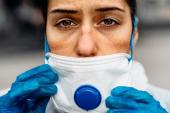

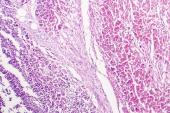
Comments